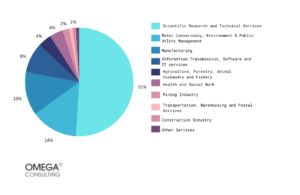- Industries
Industries
- Functions
Functions
- Insights
Insights
- Careers
Careers
- About Us
- Sustainability
- By Omega Team

Introduction
Green technology is any environmentally beneficial technology. It takes the environment into account and is grounded in environmental science. However, it goes further. Green technology is a technology that is designed to imply a positive impact on the environment for the greater good. Consider energy efficiency, renewable resources, and recycling as examples. These are all elements of green technology and the production of eco-friendly or green products.
Never before has the need for ecological technology been more apparent than it is today. Climate change has caused the dissolving of ice glaciers, resulting in rising sea levels; unpredictable weather patterns, resulting in an increase in droughts, hurricanes, tornadoes, floods, and earthquakes, and other hazardous conditions. Green technology may not be beneficial to solve all of the existing issues, but it can undoubtedly help by providing environmentally friendly products and promoting eco-friendly behaviors.
History of Green Technology
Aspects of business practices have been utilized since the Industrial Revolution, as green technology has grown in popularity in the modern era. Beginning in the early 19th century, scientists began to observe the ecological effects of coal-burning industrial facilities, and manufacturers have sought to reduce their negative environmental externalities by modifying their production processes to generate less soot or refuse products.
The Second World War that took place is considered a key point in American history. In an effort to reduce consumption and waste, over 400,000 volunteers began collecting metal, paper, rubber, and other materials for the war effort. After World War II, scientists such as Rachel Carson began to warn about the perils of chemical pesticides, while clinicians abroad reported unexplained illnesses associated with nuclear radiation. Many consider this period to be the beginning of the ecological movement, which sought to preserve ecosystems and resources while bringing attention to the negative effects of excessive technology.
Government entities came to understand the significance of protecting natural resources over time. Throughout the succeeding decades, curbside recycling programs became more prevalent, increasing public awareness of household waste. The Environmental Protection Agency, which was founded in 1970, mandated coal scrubbers and other clean technologies and imposed strict pollution and waste regulations.
Understanding Green Technology
Green technology is an umbrella term that defines the utilization of technology and science to create environmentally beneficial products and services. Green technology is related to clean technology, which refers to products or services that enhance operational performance while reducing costs, energy consumption, pollution, or environmental impacts. Green technology aims to preserve the environment, restore past environmental damage, and conserve the Earth’s natural resources. Additionally, green technology has become a booming industry that has attracted massive quantities of investment capital.
Utilization of green technology can be a proclaimed objective of a business segment or organization. Typically, these objectives are enumerated in the environmental, sustainability, and governance (ESG) statement or mission statement of a company. Increasingly, socially responsible investors are seeking to limit their potential investments to companies that employ or manufacture green technologies.
Types of Green Technology
Green technology is a comprehensive category that includes a variety of environmental remediation techniques. Despite the fact that climate change and carbon emissions are now regarded as two of the most pressing global issues, there are also numerous initiatives to resolve local environmental hazards. Some individuals aim to preserve specific ecosystems or endangered species. Others attempt to conserve limited natural resources by discovering more sustainable alternatives.
Alternative Energy
In order to provide a viable and efficient alternative to fossil fuels, numerous businesses are attempting to develop carbon-free alternatives to fossil fuels. Solar and wind energy are now amongst the least expensive energy sources, and solar panels are affordable for homeowners in the United States. Alternatives such as geothermal and tidal energy are still in the growing stage.Electric Vehicles
Environmental Protection Agency states that nearly one-third of U.S. greenhouse gas emissions result from transportation activities. By designing more fuel-efficient engines or transitioning to electrical power, a number of automakers are investigating methods to reduce vehicle emissions.
However, electric vehicles require numerous innovations in other fields, such as rechargeable batteries with high capacity and charging infrastructure. Furthermore, the reliance of many power infrastructures on fossil fuels limits the advantages of electric vehicles.
Sustainable Agriculture
Due to the considerably high costs of land and water consumption as well as the ecological effects of pesticides, fertilizers, and animal manure, agriculture, and livestock have a significant environmental impact. Consequently, there are numerous opportunities for green technology in the agricultural sector. For instance, organic agricultural techniques can reduce the damage caused by soil depletion, innovations in cattle fodder can reduce methane emissions, and meat substitutes can reduce livestock consumption.Recycling
Recycling aims to conserve finite resources through the reuse of materials or the discovery of sustainable substitutes. While plastic, glass, paper, and metal waste are the most common forms of recycling, e-waste and automobile parts can be recycled through more complex processes to recover expensive raw materials.Carbon Capture
Carbon capture refers to a collection of experimental technologies that aim to extract and store greenhouse gasses either at the site of combustion or in the atmosphere. The fossil fuel industry has promoted this technology extensively, but it has yet to live up to expectations. In comparison to annual emissions, the greatest carbon capture facility can absorb only 4,000 tons of carbon dioxide per year.Market Outlook
The market for green and sustainable energy is propelled by a surge in environmental consciousness and a rise in organizations and people’s concerns about global warming. However, the high product and solution costs associated with green technology and sustainability solutions are significant factors that will probably hinder the growth of the market to some degree. In addition, favorable government and private initiatives to combat climate change and air pollution are advantageous market factors.
Exhibit 1
Global Market for Green Technology and SustainabilityThe global market was valued at $10.32 billion in the year 2020 and is forecasted to rise at a compound annual growth rate of 21.9% and reach $74.64 billion by 2030.

Exhibit 2
Green consumer statisticsAccording to statistics, most consumers prefer purchasing from brands that contribute to the improvement in social and environmental conditions.

Exhibit 3
Classifying Green technologies for sustainable Innovation and InvestmentTo support and promote green technologies the classification is categorized by various Industries, Applications and services.

Exhibit 4
Global Green technology market share by regionThe classification depicts the percentage share occupied by various regions in the world. By region, the green technology and sustainability market has been divided into four segments namely North America, Europe, Asia-Pacific, and the Rest of the World. North America has accounted for the most of market share by percentage. Whereas Europe is anticipated to foresee the highest CAGR during the forecast period.

Green Technology in 2023
Solar energy
The advent of transparent solar panels that can be applied as a coating over windows or other surfaces to capture energy is one of the most significant developments in solar technology. This type of technology is being advanced by Ubiquitous Energy and Solar Windows.Electric Vehicles
Speaking of automobiles, some electric vehicles are beginning to incorporate conventional solar panels as a crucial component. Every solar-powered electric vehicle that exists today still needs to be plugged in for long-distance journeys. However, depending on the car, its specifications and various other parameters are responsible for the efficient utilization of electric vehicles.Fusion energy
Capturing the sun’s energy is one thing, but there are also efforts to replicate the sun’s energy on Earth. It is about fusion energy, which seeks to fuse elements together to generate energy, similar to the reactions occurring in the immense celestial crucible of our star.
A breakthrough occurred recently at the Lawrence Livermore National Laboratory when a fusion reaction produced marginally more energy than the input energy. This had never been accomplished before. Advancements like these can facilitate efficient green energy production.
Wave Energy
While solar and fusion seek to harness the power of the sun, other energy technology companies are targeting a much closer power source: the ocean. Off the coast of King Island, Australia, Wave Swell Energy’s artificial blowhole has just concluded a one-year test. The Uniwave200, inspired by a natural blowhole, directs waves into its central chamber, where compressed air spins a turbine and sends energy to the grid. Wave Swell Energy is still working to make its artificial blowhole more dependable and affordable.Another company, Eco Wave Power, is using ocean-based man-made structures as the foundation for wave energy generation. Their floaters rest on the water’s surface, where rising waves force them upward to generate fluid pressure in the system, which powers a hydro motor that turns a generator and transmits electricity to the grid via an inverter.
Roadmap to Implement Green Technology at Scale
Product and Process Innovation
Planners must ensure that the technology is ready for industrialization, as well as that the necessary manufacturing specifications and industrial processes are available for large-scale production. At this juncture, they should establish production goals and conduct product testing.Factory Configuration
Infrastructure, regulatory approvals, manufacturing equipment, and tools, including automation and robotics tools, must be protected. As production begins and increases in volume, quality reviews must be conducted.Talent Acquisition
Access to participating engineers, technicians, and procurement teams is essential, as is a strong human resources department.Supply Chain
Companies must acquire and maintain regular access to the necessary basic materials, components, packaging, and storage facilities, as well as implement the supply chain systems necessary to ensure their on-time delivery.Integration with End-Systems
Planners must determine how to integrate each green technology into final products and uses, such as those for transportation, structures, and industrial processes, as well as any necessary adaptations to ensure demand for the technology. Additionally, they must obtain the necessary regulatory approvals.Funding
Participants must secure the capital required to initiate and conclude the industrialization of each green technology, including equity funding, loans, and public subsidies.Exhibit 5
RoadMap to IndustrializationCritical green technologies must overcome six significant obstacles to achieve widespread Industrialization.

7 Ways to Become an Eco-friendly Business
1. Tracking the carbon footprint
Due to the presence of greenhouse gases (primarily carbon dioxide) in our atmosphere, global warming is currently the greatest threat to our planet. The private sector businesses are one of the largest carbon dioxide producers, so monitoring your carbon footprint is the best (and quickest) method for your business to become environmentally friendly.2. Conduct a life cycle assessment (LCA)
Irrespective of the products or services that are being offered, you can conduct a life cycle assessment (LCA) on each of them.3. Reducing the Environmental Impact
After implementing monitoring and/or performing a life cycle assessment, you can now begin to reduce your carbon footprint, minimizing your ecological footprint. You could begin by reducing business travel, converting to sustainable energy providers, installing LED light bulbs to increase energy efficiency, and partnering with environmentally responsible suppliers.4. Offsetting the emissions
You can achieve carbon neutrality or net zero by reducing your carbon output as much as possible and then purchasing carbon offsets or removal credits to offset the impact of your remaining emissions.5. Zero-waste
Assess your organization’s waste and adopt zero-waste business practices. Consider new products and procedures carefully, recycle as much as possible, and purchase used and recycled items whenever possible.6. Report on ESG
Even though not every business is legally required to publish ESG reports, doing so can help you assess and reduce your environmental impact, set goals, remain accountable, and communicate your environmental commitment internally and externally.7. Fund environmental initiatives
Consider donating to local or international environmental initiatives. Donations are required for the launch of numerous initiatives, as well as their ongoing support.Importance of Green Technology
Green or eco-technology includes sustainable or environmental technology and encompasses continuously evolving groups of methods, practices, and materials, ranging from energy-generation techniques to non-toxic cleansing agents. It considers both the long-term and short-term environmental effects of something. Green technology is, by definition, environmentally beneficial, as it incorporates energy efficiency, health and safety concerns, recycling, and renewable resources, among other factors. Renewable energy has existed for thousands of years, despite the impression that it is a novel concept. Thousands of years ago, the wind was used to propel ships across the water, and the primary sources of renewable energy throughout history were human labor, animal power, water power, wind, and biomass. It is almost inconceivable to imagine a world without fossil fuels in the present day.
However, climate change, deforestation, soil degradation, and excessive use of resources are a few of the issues that, according to experts, must be addressed in order to achieve sustainability and an eco-friendly environment on our planet.Conclusion
Currently, we face one of the most critical environmental issues of our time, which cannot be denied. Everyone should take advantage of green technology because it represents a new path forward. In the greatest interest of the planet, we can maximize our natural resources and create a sustainable environment for all.
Subscribe
Select topics and stay current with our latest insights
- Functions